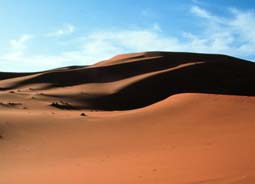

|
"...Climate
appears to limit the range of many animals, though there is some reason
to believe that in many cases it is not the climate itself so much as
the change of vegetation consequent on climate which produces the effect...
Where barriers have existed from a remote epoch, they will at first
have kept back certain animals from coming in contact with each other;
but when the assemblage of organisms on the two sides of the barrier
have, after many ages, come to form a balanced organic whole, the destruction
of the barrier may lead to a very partial intermingling of the peculiar
forms of the two regions..." |
|
At the time that Wallace published his thoughts about the global interrelationship of the changing geosphere with the biosphere, the geography, fauna and geology of the Arabian interior was unknown. Early publications (Thomas, 1894; Thomas, 1900; Yerbury and Thomas, 1895) alluded to the dispersal into Arabia of some present day African and Asian mammal faunas. However, nothing at that time could be said about the dispersal of Tertiary continental faunas into or out of Arabia as none were discovered until 1974 (Anon., 1975). In the 1930's the search for Arabian oil provided data for both topographical and geological maps, and explorations by natural historians gave insight into the fauna and flora living in a region of diverse, arid geography. Palaeontological work in the foothills of the Himalayas and in East Africa dates from the discoveries of Tertiary mammals in those regions in the late 19th century. Until recently, Arabia had been a palaeobiogeographical gap in our knowledge of Old World low-latitude continental Tertiary vertebrate faunas. |
|
|
|
![]()
[ Fossil
index - ADIAS home
]